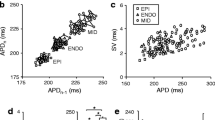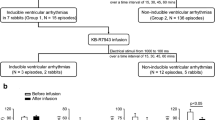Abstract.
Abnormalities of contractile function have been identified in cardiomyocytes isolated from failed human hearts and from hearts of animals with experimentally induced heart failure (HF). The mechanism(s) responsible for these functional abnormalities are not fully understood. In the present study, we examined the relationship between action potential duration, pattern of contraction and relaxation, and associated intracellular Ca2+ transients in single cardiomyocytes isolated from the left ventricle (LV) of dogs (n = 7) with HF produced by multiple sequential intracoronary microembolizations. Comparisons were made with LV cardiomyocytes isolated from normal dogs. Action potentials were measured in isolated LV cardiomyocytes by perforated patch clamp, Ca2+ transients by fluo 3 probe fluorescence, and cardiomyocyte contraction and relaxation by edge movement detector. HF cardiomyocytes exhibited an abnormal pattern of contraction and relaxation characterized by an attenuated initial twitch (spike) followed by a sustained contracture ('dome') of 1 to 8 s in duration and subsequent delayed relaxation. This pattern was more prominent at low stimulation rates (58% at 0.2 Hz, n = 211, 21% at 0.5 Hz, n = 185). Measurements of Ca2+ transients in HF cardiomyocytes at 0.2 Hz manifested a similar spike and dome configuration. The dome phase of both the contraction/relaxation pattern and Ca2+ transients seen in HF cardiomyocytes coincided with a sustained plateau of the action potential. Shortening of the action potential duration by administration of saxitoxin (100 nM) or lidocaine (30 μM) reduced the duration of the dome phase of both the contraction/relaxation profile as well as that of the Ca2+ transient profile. An increase of stimulation rate up to 1 Hz caused shortening of the action potential and disappearance of the spike-dome profile in the majority of HF cardiomyocytes. In HF cardiomyocytes, the action potential and Ca2+ transient duration were not significantly different from those measured in normal cells. However, the contraction-relaxation cycle was significantly longer in HF cells (314 ± 67 ms, n = 21, vs. 221 ± 38 ms, n = 46, mean ± SD), indicating impaired excitation-contraction uncou pling in HF cardiomyocytes. The results show that, in cardiomyocytes isolated from dogs with HF, contractile abnormalities and abnormalities of intracellular Ca2+ transients at low stimulation rates are characterized by a spike-dome configuration. This abnormal pattern appears to result from prolongation of the action potential.
Similar content being viewed by others
Author information
Authors and Affiliations
Additional information
Received 22 January 1998; received after revision 16 March 1998; accepted 27 March 1998
Rights and permissions
About this article
Cite this article
Maltsev, V., Sabbah, H., Tanimura, M. et al. Relationship between action potential, contraction-relaxation pattern, and intracellular Ca2+ transient in cardiomyocytes of dogs with chronic heart failure. CMLS, Cell. Mol. Life Sci. 54, 597–605 (1998). https://doi.org/10.1007/s000180050187
Issue Date:
DOI: https://doi.org/10.1007/s000180050187




